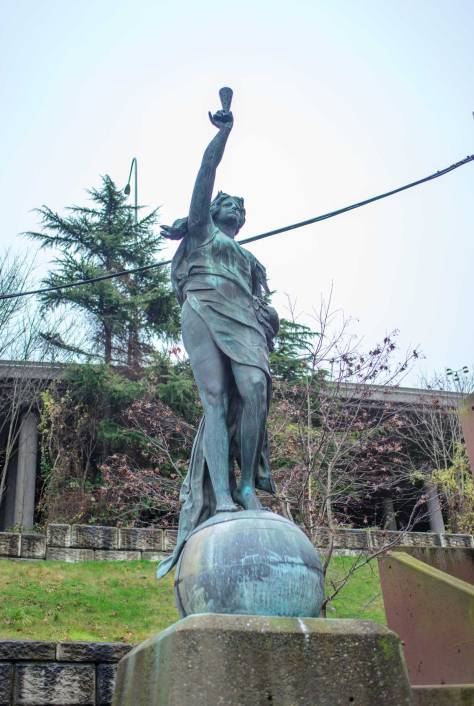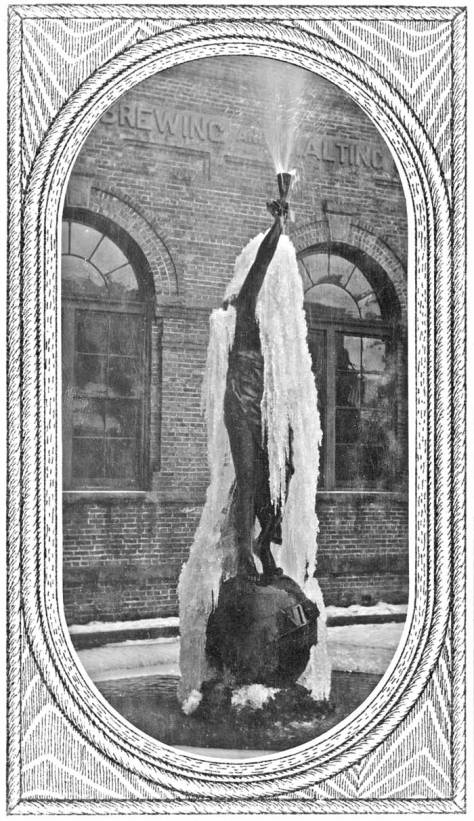(click to enlarge photos)


Here is Lady Rainier, bronzed and ten-feet tall, holding her glass high while standing in the brewery courtyard. She first appeared in the Seattle Times on February 7, 1904, for this paper’s “industrial review” of The Seattle Brewing and Malting Company. Within an elaborate montage of mostly brewery interiors, the Times included the fountain. The paper explained, that it had been “made especially for the Rainier Brewery and imported from Germany (and) is a work of art and would grace any of the city’s parks. When the water is turned on, it sprays over the glass giving the effect of foam flowing from the side.” In this undated portrait of the Lady in her courtyard, the flowing foam effect has been “interpreted” with ice.

Georgetown historian Tim O’Brian, now deceased, liked to compare his early twentieth century brewery town – before prohibition – to a medieval community where crowded in the shadow of its cathedral was everyone and everything. Here in place of a narthex, nave and chancel were a line up of Malt House, Brew House, and offices extending along Georgetown’s Snohomish Way (now Airport Way). Tim boasted, “At 885 feet it was a few feet longer than St. Peter’s Basilica in Rome – although not as wide.” When completed in 1903 and fitted with its fountain, the “Georgetown Cathedral” could readily claim devotional status as “the largest brewery in the west.”

By 1906 Rainier brewery was producing 300,000 barrels of beer – or spirits – a year. It required twenty-five horse teams to handle deliveries consumed daily in Seattle alone. But the Golden Gate State statistics were the most impressive. In 1911 if you were drinking beer – or shampooing your hair with it – most likely it was with Rainier. On average twenty-five carloads of Rainier Beer were delivered daily by rail to California.
When the expanding brewery needed the Lady Rainier’s courtyard for a machine shop, she began her pilgrimage to several locations in and even atop the brewery. Too soon, however, Georgetown’s “only employer” was turned off as was its fountain – first for statewide prohibition in 1916, when the company moved to San Francisco. National prohibition followed in 1920.
In this week’s repeat, Lady Rainier looks down from her perch beside the “other” Rainier Brewery, also on Airport Way, but in South Seattle, less then two miles north of the remnants of the Georgetown Brewery. In recent years the Georgetown Community Council has hoped to bring the Lady home to Georgetown’s Oxbow Park to stand beside another restored and protected Georgetown landmark, the Hat ‘n’ Boots.
MOVING LADY RAINIER
Georgetown historian Tim O’Brian thought that 1959 was the likely date for this moving of Lady Rainier.
WEB EXTRAS
Anything to add, Paul? YUP! Ron Edge first. Ron will attached to images that will link to two former Features that relate. I’ll follow that with a few Georgtown photos – and Rainier Beer too.
CLICK-CLICK TO ENLARGE
HOW TO BE SICK
Last week’s stay in the University of Washington Hospital answered many years of wondering what it would be like to be put in a bed there. The irritation of being awakened thru the night for samples and tests is softened by the generally good humor of those – nurses mostly – who are poking you awake. And when my appetite returned I was hoping to stay longer, for the menu is quite good and the preparation too. Rather I was encourage to get out during my 5th day, and so with Jean and Genny’s help I left with my four drugs and a long list of appointments for more tests and a variety of acts called procedures. Now to confirm for Marc Cutler – of both the Old Fools and the Not Dead Yet societies, I am, indeed, not dead yet.


















I like your Post. Here is a small note about my recent trip to Seattle. Zulu Delta http://zuludelta45.net/2014/02/16/ah-hello-its-the-road-to-the-bat-cave-duh/
If you look closely at photo # 2 of the statue, you will see two drilled holes (two of four), where at one time a bronze plaque was installed describing the history of the piece. Shortly before the Seattle brewery closed, someone sheared off the bolts holding the plaque, and ran off with it. An unfortunate loss of a bit of history.